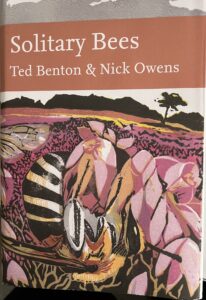Solitary Bees By Ted Benton & Nick Owens review
This is my second review of a book by Ted Benton. I enjoyed the much smaller first book and when I asked him why he wrote the first Solitary Bee book, his comments were just as appropriate for this second book. However, there are so many more details in the second version and to be honest I am blown away by the second book, jointly written with Nick Owens. Here is a brief review.

I was gifted this magnificent book by the authors. It was so informative and I am learning so much more about solitary bees that I decided to write a brief review about it, to help it reach a wider audience. Being an academic book, though written in easy-to-digest format it’s not cheap although you can purchase it a lot cheaper on various websites as an ebook.
Both are authors and entomologists with many years of experience. They don’t concentrate on identifying specific species with detailed diagrams, keys etc., in great detail instead they concentrate on their interests, that is behaviour and ecology. Other books are available for identifying solitary bees e.g. The Field Guide to the Bees of Great Britain and Ireland, by Steven Falk.
The authors mention Gasteruption jaculator several times so here is a film of one ovippositing inside a common yellow face bee nest, probably very rarely filmed.
The Authors, both of whom have written books about bees before, describe in great detail their behavioural observations, (and that of many other peoples’ observational/behavioural/studies) on solitary bee behaviour. The vividly and detailed written observations I enjoyed. Especially when reading something completely new to me.
For example, I had never seen or heard anything at all about the mutillid wasps, which is not surprising for me, as they appear way down south and are found only sporadically in northern England and central Scotland. They are described as the ‘velvet wasp’, its colour probably acting as a warning to potential predators, (Aposematism). These wasps have a painful sting, which they use to defend themselves.
So many species- scarcity of literature
There are more than 7,000 species. of this wasp. Even in Prof. Seirian Sumner’s excellent book, “Endless Forms. Why We Should Love Wasps” she admits that the family to which it belongs, Mutillidae, has very little to find in the scientific literature on the predator-prey relationship of this family and several other families. The authors describe how winged males of some species of mutillid wasps carry the wingless female in flight and potentially take her to an area where a variety of wasps and bees are likely to be nesting!
According to BWARS, they are known to be parasitoids of the resting stages of other insects, which are inside cocoons.
And boy, I am learning such a lot of new information. The authors certainly scored highly for achieving this with me. It is a real coup for the authors, the New Naturalist Library and for us, the readers by having so much information about solitary bees from experienced bee observers with so much interesting information to digest.
What the book covers
Male courtship behaviour, sex and the solitary bee, life cycles, nesting behaviour and development, flowers, cuckoos, parasites, predators and more are all covered.
This is a very timely addition as more and more people are aware of the different species of bees and not just concentrating on honeybees and bumblebees. Wildlife gardening is now undertaken by many people which has helped people to appreciate solitary bees. Consequently, their awareness of solitary bees expanded. This book will vastly improve their knowledge and understanding of them.
As we roll up towards Christmas, this book would make an excellent present for any budding entomologist or even the more seasoned one. It can be bought here
I would like to thank the authors for mentioning my work several times throughout the book.
You may find this paper interesting Associations of mutillid wasps (Hymenoptera, Mutillidae) with eusocial insects

Recent Comments